Street name sign

A street name sign is a type of traffic sign used to identify named roads, generally those that do not qualify as expressways or highways. Street name signs are most often found posted at intersections, and are usually in perpendicularly oriented pairs identifying each of the crossing streets.
Description



Modern street name signs are mounted on either utility poles or smaller purpose-made sign poles posted on a streetcorner, or hung over intersections from overhead supports like wires or pylons. Up until around 1900 in America, however, street name signs were often mounted on the corners of buildings, or even chiseled into the masonry, and many of those signs still exist in older neighborhoods. They are commonly used in France and England.
A street name sign may optionally indicate the range of house numbers found nearby. Some street name signs also indicate an alternative name for the street, such as "Fashion Avenue" for Seventh Avenue in New York City, or "Avenue of the Arts" for Huntington Avenue in Boston, Massachusetts. Multilingual signs are common and may be required by law in some areas, such as French-speaking regions of Canada.
Most streets have a traffic sign at each intersection to indicate the name of the road. The design and style of the sign is usually common to the district in which it appears. The sign has the street name and sometimes other information, such as the block number or the name of the London borough in which the street is located. Such signs are often the target of simple vandalism, and signs on unusually or famously named streets are especially liable to street sign theft.
In recent years, many US and Canadian cities have adopted the mast arm for traffic signal equipment; major intersections are marked with large signs mounted on the mast arms. This was started in the 1960s by the California Department of Transportation. Los Angeles and San Francisco started in the 1970s and recently New York City has introduced the bigger signs at its intersections. In 2013, New York City began to change street signs that have been previously used Highway Gothic font for a new one, Clearview, that include both upper and lower case letters, which is considered more readable.[1]
Color coding and typography
Usually, the color scheme used on the sign just reflects the local standard (for example, white letters on a green background are common throughout the US). However, in some cases, the color of a sign can provide information, as well. One example can be found in Minneapolis, Minnesota. Within its city limits, all major arterial roads use a blue sign, north-south roads use a green sign, and east-west roads use a brown sign. Other places sometimes use blue or white signs to indicate private roads.
As of 2009, the Manual on Uniform Traffic Control Devices (MUTCD) approved color schemes for street name signs including a green, blue, or brown background with white text, or a white background with black text.[2] Despite the MUTCD restriction only to the aforementioned color schemes, other color schemes are used in some cities; for example, the city of Mesa, Arizona uses ruby red colored street name signs at signalized intersections in the Fiesta District in the western part of the city. The city of Houston, Texas allows for street name signs in several of its neighborhoods (usually part of a management district, where property owners assess additional fees to themselves to pay for extra services) to be of significantly different color schemes and fonts than the city-wide standard.
In 1952 in the UK, David Kindersley submitted a design, MoT Serif, to the British Ministry of Transport, which required new lettering to use on United Kingdom road signs. Although the Road Research Laboratory found Kindersley's design more legible, the all-capitals design with serifs was passed over in favour of that of Jock Kinneir and Margaret Calvert. Many of the street signs in England, especially in Cambridge, use Kindersley fonts.[3]
Gallery
- Street name signs
.jpg)
- Internally illuminated mast-mounted street sign in California
 Example in Bukhara
Example in Bukhara Bilingual signage in Fort William, Scotland with bicycles
Bilingual signage in Fort William, Scotland with bicycles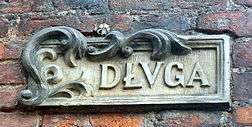 Street sign at Długa Street in Gdańsk
Street sign at Długa Street in Gdańsk
 East Berlin street sign for the former Marx-Engels-Platz (1984)
East Berlin street sign for the former Marx-Engels-Platz (1984).jpg) Augustinergasse
Augustinergasse- Historic Hungarian/German street sign in Bratislava
 Spanish street sign, Calle Laurel
Spanish street sign, Calle Laurel- Haifa, Israel
- Street sign, Hong Kong
- Street sign, Macau
 Bilingual sign in Texas
Bilingual sign in Texas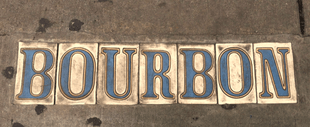 Tiles in the sidewalk mark some streets in the French Quarter of New Orleans
Tiles in the sidewalk mark some streets in the French Quarter of New Orleans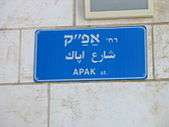 A street sign in Jaffa Israel
A street sign in Jaffa Israel- A street sign in Montmartre, Paris
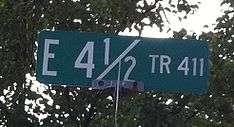 Four and a half street in Berwick, Pennsylvania
Four and a half street in Berwick, Pennsylvania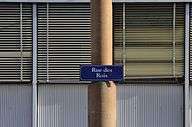 Street name sign in Geneva, Switzerland
Street name sign in Geneva, Switzerland.jpg) "President´s Corner" in Windhoek, Namibia
"President´s Corner" in Windhoek, Namibia
See also
| Wikimedia Commons has media related to Street signs. |
External links
- Language of the Street - an analysis of street signs in Newcastle-upon-Tyne, Colchester, London and other UK cities.
References
- ↑ Bacho, Katia (June 24, 2013). "On the Street Clarity". The New Yorker (subscription needed). p. 30.
- ↑ "Manual on Uniform Traffic Control Devices 2009 Edition Chapter 2D. Guide Signs—Conventional Roads". Federal Highway Administration. Retrieved March 4, 2015.
- ↑ Richard Kindersley Studio official website